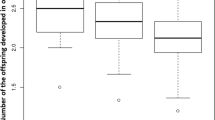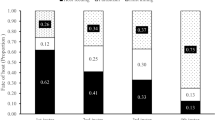Abstract
Female Spalangia cameroni produced more offspring from younger house fly pupae, both when given a choice of host ages and when not given a choice. Host age did not affect offspring survivorship. Offspring were larger when they had developed on younger hosts and the effect was independent of offspring sex. Having previously parasitized old hosts versus young hosts did not reduce a female's production of offspring in subsequent hosts. Females distinguished between young and old hosts both in the light and in the dark. Females did not distinguish between host ages prior to physical contact with the host but could distinguish by the time they first began exploring a host by tapping it with their antennae; thus, they could distinguish before drilling into a host.
Similar content being viewed by others
REFERENCES
Coats, S. A. (1976). Life cycle and behavior of Muscidifurax zaraptor (Hymenoptera: Pteromalidae). Ann. Entomol. Soc. Am. 69: 772–780.
Donaldson, J. S., and Walter, G. H. (1984). Sex ratios of Spalangia endius (Hymenoptera: Pteromalidae), in relation to current theory. Ecol. Entomol. 9: 395–402.
Epting, R. J., and Casey, T. M. (1973). Power output and wing disc loading in hovering hummingbirds. Am. Nat. 107: 761–765.
Gerling, D., and Legner, E. F. (1968). Developmental history and reproduction of Spalangia cameroni, parasite of synanthropic flies. Ann. Entomol. Soc. Am. 61: 1436–1443.
Godfray, H. C. J. (1994). Parasitoids, Princeton University Press, Princeton, NJ.
Hunter, C. D. (1994). Suppliers of beneficial organisms in North America. Calif. Environ. Protect. Agency PM: 94–03.
Kammer, A. E., and Heinrich, B. (1978). Insect flight metabolism. Adv. Insect Physiol. 13: 133–228.
King, B. H. (1988). Sex-ratio manipulation in response to host size by the parasitoid wasp Spalangia cameroni: A laboratory study. Evolution 42: 1190–1198.
King, B. H. (1990). Sex ratio manipulation by the parasitoid wasp Spalangia cameroni in response to host age: A test of the host-size model. Evol. Ecol. 4: 149–156.
King, B. H. (1991). A field study of host size effects on sex ratio of the parasitoid wasp Spalangia cameroni. Am. Midl. Nat. 125: 10–17.
King, B. H. (1994). How do female parasitoid wasps assess host size during sex-ratio manipulation? An. Behav. 8: 511–518.
King, B. H. (1997). Effects of age and burial of house fly pupae (Diptera: Muscidae) on parasitism by Spalangia cameroni and Muscidifurax raptor (Hymenoptera: Pteromalidae). Environ. Entomol. 26: 410–415.
King, B. H., and King, R. B. (1994). Sex ratio manipulation in response to host size in the parasitoid wasp Spalangia cameroni: Is it adaptive? Behav. Ecol. 5: 448–454.
King, B. H., and Lee, H. E. (1994). Test of the adaptiveness of sex ratio manipulation in a parasitoid wasp. Behav. Ecol. Sociobiol. 35: 437–443.
Markwick, N. P. (1974). A Comparative Study of Four Housefly Parasites (Hymenoptera: Chalcidoidea), Ph.D. thesis, Victoria University, Wellington, New Zealand.
Moon, R. D., Berry, I. L., and Petersen, J. J. (1982). Reproduction of Spalangia cameroni Perkins (Hymenoptera: Pteromalidae) on stable fly (Diptera: Muscidae) in the laboratory. J. Kans. Entomol. Soc. 55: 77–85.
Morgan, P. B., LaBrecque, G. C., Weidhaas, D. E., and Patterson, R. S. (1979). Interrelationship between two species of muscoid flies and the pupal parasite Spalangia endius (Hymenoptera: Pteromalidae). J. Med. Entomol. 16: 331–334.
Morgan, P. B., Berti-Filho, E., and Costa, V. A. (1991). Life history of Spalangia gemina Boucek (Hymenoptera: Pteromalidae), a fast breeding microhymenopteran pupal parasitoid of muscoid flies. Med. Vet. Entomol. 5: 277–281.
Nechols, J. R., and Kikuchi, R. S. (1985). Host selection of the spherical mealybug (Homoptera: Pseudococcidae) by Anagyrus indicus (Hymenoptera: Encyrtidae): Influence of host stage on parasitoid oviposition, development, sex ratio, and survival. Environ. Entomol. 14: 32–37.
Petersen, J. J., and Matthews, J. R. (1984). Effects of freezing of host pupae on the production of progeny by the filth fly parasite Muscidifurax zaraptor (Hymenoptera: Pteromalidae). J. Kans. Entomol. Soc. 57: 387–393.
Pierce, N. E., and Elgar, M. A. (1985). The influence of ants on host plant selection by Jalmenus evagoras, a myrmecophilous lycaenid butterfly. Behav. Ecol. Sociobiol. 16: 209–222.
Rabinovich, J. E. (1970). Population dynamics of Telenomus fariai (Hymenoptera: Scelionidae), a parasite of Chagas' disease vectors. II. Effect of host-egg age. J. Med. Entomol. 7: 477–481.
Rice, W. R. (1989). Analyzing tables of statistical tests. Evolution 43: 223–225.
Rueda, L. M., and Axtell, R. C. (1985). Guide to Common Species of Pupal Parasites (Hymenoptera: Pteromalidae) of the House Fly and other Muscoid Flies Associated with Poultry and Livestock Manure, Technical Bulletin 278, North Carolina Agricultural Research Service, North Carolina State University, Raleigh.
Ruohomäki, K. (1992). Wing size variation in Epirrita autumnata (Lep., Geometridae) in relation to larval density. Oikos 63: 260–266.
Sandlan, K. P. (1979). Sex ratio regulation in Coccygomimus turionella Linnaeus (Hymenoptera: Icheumonidae) and its ecological implications. Ecol. Entomol. 4: 365–378.
Schmidt, J. M., and Smith, J. J. B. (1985). Host volume measurement by the parasitoid wasp Trichogramma minutum: The roles of curvature and surface area. Entomol. Exp. Appl. 39: 213–222.
Siafacas, V. (1980). Biology of Spalangia nigroaenea Curtis (Hymenoptera: Pteromalidae), a Pupal Parasite of the House Fly, Musca domestica L., Ms. thesis, North Carolina State University, Raleigh.
Takagi, M. (1986). The reproductive strategy of the gregarious parasitoid, Pteromalus puparum (Hymenoptera: Pteromalidae). 2. Host size discrimination and regulation of the number and sex ratio of progeny in a single host. Oecologia (Berl.) 70: 321–325.
Trimble, R. M., and Wellington, W. G. (1979). Effects of salinity on site selection by ovipositing Aedes togoi (Diptera: Culicidae). Can. J. Zool. 57: 593–596.
van Alphen, J. J. M., and Janssen, A. R. M. (1982). Host selection by Asobara tabida Nees (Braconidae, Alysiinae), a larval parasitoid of fruit inhabiting Drosophila species. II. Host species selection. Neth. J. Zool. 32: 215–231.
van Alphen, J. J. M., and Thunnissen, I. (1983). Host selection and sex allocation Pachycrepoides vindemiae Rondani (Pteromalidae) as a facultative hyperparasitoid of Asobara tabida Nees (Braconidae: Alysiinae) and Leptopilina heterotoma (Cynipoidea: Eucoilidae). Neth. J. Zool. 33: 497–514.
Waage, J. K. (1986). Family planning in parasitoids: Adaptive patterns of progeny and sex allocation. In Waage, J. K., and Greathead, D. (eds.), Insect Parasitoids, Academic Press, London, pp. 63–95.
Wylie, H. G. (1963). Some effects of host age on parasitism by Nasonia vitripennis (Walker) (Hymenoptera: Pteromalidae). Can. Entomol. 95: 881–886.
Wylie, H. G. (1967). Some effects of host size on Nasonia vitripennis and Muscidifurax raptor (Hymenoptera: Pteromalide). Can. Entomol. 99: 742–748.
Zar, J. H. (1984). Biostatistical Analysis, 2nd ed., Prentice-Hall, Englewood Cliffs, NJ.
Author information
Authors and Affiliations
Rights and permissions
About this article
Cite this article
King, B.H. Host Age Response in the Parasitoid Wasp Spalangia cameroni (Hymenoptera: Pteromalidae). Journal of Insect Behavior 11, 103–117 (1998). https://doi.org/10.1023/A:1020822717975
Issue Date:
DOI: https://doi.org/10.1023/A:1020822717975




